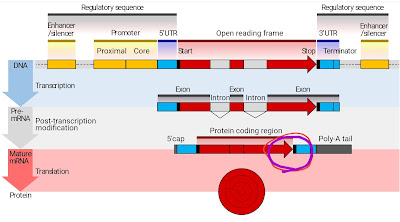According to Betteridge's Law of Headlines, any headline that ends with a question mark can be answered by the word "no". What, you want more? OK then...
A paper published in February 2022 caused a stir in the anti-vaccine community as it appeared to show a mechanism by which the RNA in certain vaccines might end up in the genomes of vaccinees, potentially even being passed to offspring. The fuss died down somewhat, but has been reamplified by molecular-biology-naïf (but, I'm sure, great cardiologist) Dr Peter McCullough. Unfortunately, as ever, the scare is easily articulated, the refutation requires lengthy consideration of detailed mechanism.
"Vaccines can turn our cells into eternally spike-producing factories!!! And our babies!!!!".
Tl;dr: No they can't.
Here's a basic schematic of the molecular biology of the situation:
The normal information flow is from DNA sequence in the genome to RNA ('messenger' or mRNA) to amino acid sequence in protein.
1) Transcription. In the cell nucleus, the organism's DNA contains regions that can be transcribed into the closely related molecule RNA. This depends on the state of any 'enhancer/silencer' regions, which can occur upstream or downstream of the copied segment. They act like logic gates that are bound to by control molecules: Enhancers turn the gene on if bound, silencers turn it off. If all these switches are set appropriately (enhancers all bound and silencers all unbound) the promoter region can bind factors that initiate transcription. This makes an RNA copy of the protein coding segment (open reading frame, or ORF) but also some important regions upstream and downstream of that (untranslated regions, or UTRs).
2) The raw transcript is processed. Some regions (introns) are snipped out, a "5' cap" is added at the head and a '"poly-A tail" stuck on the other end.
3)
Translation. In the cell's cytoplasm, a ribosome assembles around the mature mRNA, binding to a specific sequence in the "5' UTR" (thus, an intact 5'UTR is vital) and translating the coding region into protein.
The 'trick' exploited by the RNA vaccines is to sneak an RNA into this system disguised as a normal 'mature mRNA' produced by the above sequential process, cutting straight to stage 3. It has a viable 5' UTR, 3' UTR and poly-A tail. But notably, it does not have any sequence that could provide a promoter region if, by some means, it could be turned back into genomic DNA. So we would expect it to be 'silent' even if that happened.
But can even that happen? Let's look at the paper that causes McCullough such inexplicable glee (they love it when a problem pops up they can add to the quiver!).
This paper investigated the possibility that a 'transposable element', LINE-1, might provide a means by which vaccine mRNA gets into the genome. They did so by taking a cell line derived from a liver cancer, flooding it with vaccine mRNA, and looking for a DNA copy of their chosen fragment of the vaccine RNA. They found it.
Note, however, what they didn't demonstrate:
- integration of this DNA into the cells' genomes.
- transcriptional viability of this DNA in the event of its integration
- that this DNA included the full length of the RNA code, including the 5' UTRs essential for subsequent translation.
- Any preference of this mechanism for vaccine RNA as opposed to any other they might have chosen to flood it with, such as host mRNAs, or those of any viruses they happened to be infected with.
Discussion:
The information flow from DNA through RNA to protein depicted above is normally one-directional for sound biological reasons. It would be disruptive, and possibly carcinogenic, if the arrows were reversed and RNA was routinely converted into genomic DNA. Our genome would bloat with reverse-transcripts of RNAs just copied from it. For this reason, we don't have a natural reverse transcriptase - an enzyme performing this reverse copy from RNA back to DNA. Many viruses do (though not SARS-CoV-2), but not us.
However, there are elements all over our genomes called LINE-1 which do encode a reverse transcriptase. LINE-1 is likely a 'domesticated virus' which now gains copies by copy-pasting itself around the genome rather than passing between organisms as a true virus. A viable LINE-1 copy in DNA contains two protein-coding regions. ORF1 is a 'chaperone' that can bind to and escort RNA. ORF2 has reverse transcriptase activity and can recognise and snip a specific DNA target sequence in the genome to integrate that reverse transcript. When LINE-1 RNA is translated (stage 3 above) the ORF1 and ORF2 proteins form a complex with the RNA they were just made from, carrying it back to the nucleus, and converting that RNA into DNA and inserting it at chromosomal sites that possess the specific short recognition sequence, gaining a copy.
Hypothetically, the ORF1 and ORF2 of LINE-1 could bind to any old RNA. The likeliest target is the RNA from which they have just been synthesised - it's physically the closest - but could occasionally drift over to grab a nearby RNA and work its magic on that instead. So if you flood a cell with an RNA - could be a vaccine, could be a virus, could be a bog-standard host mRNA - it's quite likely that this would be the sequence you found in any secondary-target DNA. So if this is a worry for vaccines, it's also a worry for virus. It isn't though.
LINE-1 is highly expressed in cancerous cells (which these cells are: a cell line called Huh7). This is not representative of typical cells, in which transposable elements are generally repressed (because they can themselves be carcinogenic). Nonetheless some 17% of our genome is the debris of LINE-1 pasting itself in this manner, so over evolutionary time it has been quite successful. But most of those LINE-1s are dead; usually, it 'breaks on landing', being incomplete.
DNA and RNA strands both have a 'direction'. One end is labelled 5', the other 3'. The two strands of a DNA double helix are laid head-to-tail; the 3' direction on one strand is the 5' direction of the other. In the above image, then, the DNA strand actually has 3' on the left, 5' on the right (the labels 5'UTR and 3' UTR for the blue regions in the DNA refer to the directions after transcription to RNA, not the directions in DNA). The same logic applies to reverse transcription. To make DNA from RNA, you work along the template from right to left according to the above picture: you start at the 'end' (3') and work towards the 'beginning' (5'). So, often, the copying stops before it gets to the 5'UTR, which is essential if the DNA version is to be successfuly transcribed later, because it's where the ribosome binds, among other things. Even with a successful end-to-end copy, polymerisation needs a few untranscribed bases at the 3' end to grip on, and drops a few at the 5' end, so a viable transcript is not guaranteed.
Note, however, that the authors of this paper chose to identify a reverse-transcript using only a fragment (ID'd by PCR - I wonder how many people touting this would also say
PCR does not work!). They chose a segment at the 'end', which I've clumsily highlighted below, but this does not demonstrate anything more than that the back end of the RNA has been picked up and copied. We need to see a viable, translatable transcript, not a fragment.
The relevant figure from the paper shows that 444 bases at the back end of the 4284-base full sequence were used to denote a 'hit'. A viable gene would need all 4284 bases, which was not demonstrated.

Additionally, even if the reverse transcript included the full translatable gene, it would have to acquire a promoter from somewhere in order to be subsequently transcribed. But there is nothing in the vaccine RNA to make a promoter from. How does LINE-1 get round this? After all, it is transcribed. Well, it has an
internal promoter. Instead of sitting outside the RNA's 5'-3' brackets, it lies between. This means, if you get to the 5' UTR, you have already copied the promoter. This isn't the case for most other RNAs, so any that do integrate in this way are likely to be silent, lacking a promoter.
Even if it happens, it happens in one cell only each time. The likeliest fate for that cell, if it expresses this foreign protein, is destruction by the immune system - which is kind of what we want! Do we care if the source of the protein was vaccine mRNA -> RT -> transcription -> translation, rather than vaccine mRNA en direct?
If it gets past this checkpoint, to be problematic it would need to be replicated - being present in a single cell among trillions is not really a major threat. Certainly in adults, many cell lines have done replicating; it would need to get into stem cells to proliferate. In growing kids this might be slightly more of an issue, but no more for vaccine than any other RNA.
As far as the next generation is concerned, it would need to get into the parental germline. In females this is rather unlikely since her germline divisions have already ended when she is born - all the eggs she's ever going to make were held in a kind of suspended animation prior to the final separation stage of meiosis while she was still a foetus. Germline LINE-1 activity is suppressed (as indeed it is in general; it is potentially carcinogenic). So again, we're piling on the improbability. Different in males, but again we are not likely to see huge numbers of spermatogonia affected by this very occasional (if at all) mechanism, and hence, only a tiny proportion (if any) of sperm.
But
even if it gets through this set of filters and ends up in a baby, producing spike, the immune system will not attack it. If that happened routinely, protein evolution would be impossible. The genome of a developing embryo is all 'self' - nothing 'knows' that a given protein doesn't belong there; the two protein sets from the two parents have never encountered each other before. The self/non-self distinction of a new individual does not depend on what the parental immune system would have thought of the matter. The slate is wiped clean. Of course the McCulloughs of this world say that spike is inherently 'toxic', and not simply an invitation for immune destruction. Yet the only evidence for that comes from experiments in which it is attached to a virus and trying to get in. This spike is already 'in', and is not virus-attached.
Of course any concession - 'likely to be', 'may be', 'if' - is no comfort to those who like their science to come neatly dichotomised into certainties and impossibilities. It is quite possible that, in some cell in some individual somewhere, this mechanism has resulted in integration of a fragment of vaccine RNA. But why would you be worried by that but not the far greater incidence of insertion of actual LINE-1s, of viral RNA, of reverse transcripts of our normal cellular mRNAs? Most cells, most of the time, don't have vaccine mRNA in them. But they
always have non-vaccine mRNAs, and often have viral RNA. Maybe a little perspective would be in order?




Comments
Post a Comment